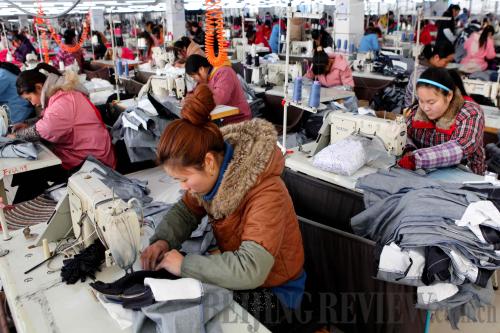|
 |
|
LABOR INTENSIVE: Workers at a garment factory in Ganyu County, east China's Jiangsu Province, make clothes for overseas clients (XINHUA) |

The world economy is mired in a real global crisis for the first time in the age of globalization. When people worldwide review the crisis, they should not simply conclude that the answer is finding a way to strengthen financial regulation or to balance the global economy. At a time when major Western economies are performing poorly, the world should begin to seek the root of the crisis in social, economic and political structures. If the crisis stems from structural problems, that means there are problems with the current development models. That is to say, the current crisis is a crisis of development models.
The Anglo-Saxon economic pattern could hardly be absolved from the blame of the U.S. subprime mortgage crisis, which dragged down the economy of the United States. This pattern has been prevailing since the era of Ronald Reagan, U.S. President from 1981-89, and Margaret Thatcher, British Prime Minister from 1979-90. In the 1980s, the United States and Britain began market-oriented reforms. The reforms of both countries advocated free trade and capital flow by reducing government meddling in the economy, encouraging market competition and deregulation. These measures greatly stimulated market dynamism and creativity, promoted rapid economic growth and helped boost Western prosperity.
But the unconstrained market-driven economy caused a market-first and shareholder benefit-focused laissez-faire status. In the United States, the profits of the financial sector as a percentage to the total profits of listed companies soared to 40 percent from 5 percent two decades ago. The whole American society tumbled into a fever to seek fortune in the name of financial innovation. Lobbying from powerful financial groups blinded Congress and the lust for profits overthrew financial regulatory bills. In the meantime, the U.S. Government adjusted its financial policies from controlling risks to promoting development of the financial industry. The relationship between government regulators and the financial industry changed from regulation to collusion. The financial sector gradually hijacked U.S. political and economic systems, resulting in a crisis of the Anglo-Saxon economic model.
Germany and many other Western European countries pursue a "social market economy." This economic model, known as Rhine capitalism, seeks to strike a balance between rapid economic growth on the one hand and low inflation, low levels of unemployment, good working conditions and social welfare on the other hand, by using state intervention including taxes and a social security system. Japan also follows this model.
Rhine capitalism was an outcome of the violent conflicts between labor and capital during European industrialization. With government intervention, the free market economy was modified to some degree. The cooperation between the state and the private sector created a rich and relatively harmonious Europe. And most Europeans are proud of their lifestyle. The seemingly perfect economic model, however, is beset with ethical problems. Within a country, the government could provide social welfare through the redistribution of wealth, but within the euro zone, it is impractical to ask Germany to bail out debt-ridden Greece.
Moreover, under the current Western political election system, it is difficult to balance equity and efficiency. To get more support, politicians often adopt expensive social welfare programs at the cost of running a fiscal deficit, which will eventually cause structural problems such as rigid markets and economic stagnation. Even during the Greek debt crisis, the Greek Government held referendums on its policies, showing the inefficiency of its decision-making.
The export-oriented East Asian economic model, which took shape in the 1990s, is the synthesis of the successful economic development experience of some countries and regions in East Asia. It is an innovative model that emerged against a non-Western cultural background. The economic takeoff of South Korea, Singapore and China's Taiwan and Hong Kong not only shows the successful application of Western experience in the East, but also provides a driving force and favorable external conditions for the economic development of China, the largest East Asian country.
|
